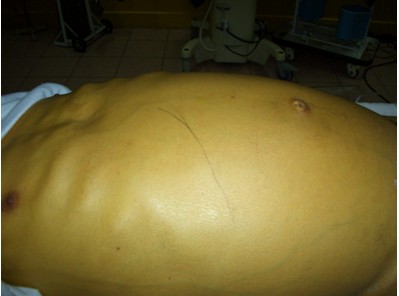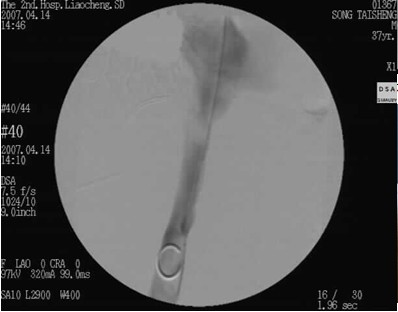- Date:2020-10-08
Interventional medicine - known as the three major diagnostic and treatment techniques alongside medicine and surgery
● Do you know what intervention is all about?
◇It is based on medical imaging, and under the guidance of image monitoring, through the percutaneous puncture route or the body's original orifices, it uses puncture needles, catheters and other interventional devices to directly insert them into the diseased areas for the diagnosis and treatment of diseases. It is a minimally invasive discipline that intervenes catheters or instruments into almost all the branches of blood vessels in the human body, the ducts of the digestive, urinary and other systems, and other specific parts of the human body for the treatment of diseases.
According to the path to the lesion, there are two types of interventions: endovascular and non-vascular.
Endovascular intervention: Using a 1~2mm puncture needle, the artery is punctured percutaneously to enter the human body's vascular system, and under the guidance of the angiography machine DSA, the catheter is sent to the location where the lesion is located, and the contrast agent is injected through the catheter to show the situation of the lesion's blood vessels, so that the treatment of the lesion can be carried out within the blood vessels. Including: arterial chemotherapy, arterial embolisation, angioplasty, etc.
Non-vascular intervention: direct puncture to the lesion through the skin, or entering the lesion through the existing pipeline in the body, to treat the lesion. Including: percutaneous puncture tumour biopsy, intratumoural drug injection, percutaneous puncture intervertebral disc extraction, and so on.
● What are the characteristics of minimally invasive interventional therapy?
Interventional minimally invasive is characterized by small trauma, safety, high efficiency, fewer complications and significantly shorter hospitalization time. (1) The advantage of interventional therapy compared with internal medicine is that the drugs can be given through the catheter to act directly on the lesion site, which can increase the concentration of drugs in the lesion site by 10-30 times, reduce the dosage of drugs, and lower the side effects of drugs. (2) The advantages of interventional therapy compared with surgical treatment are: only local anesthesia, skin incision of a few millimeters, can complete the more complex treatment, epidermal damage is small, beautiful appearance.
● What diseases can minimally invasive intervention treat? How effective is it?
Interventional minimally invasive treatment can be applied to diseases of various systems of the whole body, for example, malignant tumours, benign tumours, gynaecological diseases, haemorrhagic diseases, obstructive diseases, ischemic necrosis of the femoral head, liver abscess, liver and kidney cysts, etc. Benign lesions can be completely cured, haemorrhagic diseases can be seen immediately, and the efficacy of malignant lesions is more satisfactory.
Treatment of ◇liver cancer-Hepatic artery chemoembolisation
The blood supply of liver cancer is mainly the hepatic artery. Insert the catheter into the hepatic artery to find the small arteries supplying the growth of tumour, which is also called the ‘target artery’, and inject the drugs directly into the tumour area through the catheter, and the concentration of the drugs in the tumour area can be increased by 10-30 times, and at the same time, part of the drugs + iodine oil can be injected into the tumour area to achieve the purpose of killing the tumour cells. At the same time, part of the drug + iodine oil is emulsified and injected into the tumour area to achieve the purpose of killing the tumour cells, and then the arteries are blocked after the injection of the drug, which is also known as embolism, aiming at cutting off the nutrition supplied to the tumour, so that the tumour is ‘starved to death’ to achieve the therapeutic purpose, which is also known as medical resection.
Super-selective hepatic artery embolisation for ◇hepatic hemangioma
Hepatic hemangioma is a benign tumour of liver, and the interventional therapy mainly consists of super-selective hepatic artery embolization, which cuts off the blood supplying artery of hemangioma and makes the hemangioma suffer from ischemia, hypoxia, atrophy and necrosis, with small trauma, good curative effect and quick recovery, and it can achieve complete cure.
◇Uterine Fibroid-Uterine Artery Embolisation
Uterine fibroids are the most common type of benign tumour, and about 20% to 25% of women of childbearing age have uterine fibroids, which are often manifested by menstrual changes such as excessive menstruation and abdominal masses, which bring heavy physical and psychological burdens to patients. Interventional therapy is to block the blood supply artery of uterine fibroids to make the tumour ischemic necrosis and detachment to achieve the purpose of cure, which has the characteristics of small trauma, no open abdomen, and retaining the function of uterus, and it was formally regarded as the uterine fibroids treatment method that can replace hysterectomy in 1995, and it achieves the purpose of replacing surgery.
◇Tubal Obstruction Infertility - Tubal Re-opening Surgery
Tubal obstruction is a common disease in obstetrics and gynaecology, accounting for about 1/3 of the causes of female infertility patients, and the common causes are tubalitis and tubal lining tuberculosis. Tubal recanalisation is the most advanced treatment method at home and abroad at present, which makes use of special instruments and ultra-smooth guide wire to unblock the adherent tubes, and has a high rate of success in recanalisation, is safe and reliable, has little damage, and has a quick recovery.
◇Obstructive Jaundice-Percutaneous Hepatic Puncture Biliary Drainage
Obstructive jaundice is a disease in which the symptoms such as yellowing of the skin, yellowing of the sclera, itching of the skin, deep yellowing of urine, clay-coloured stools, increase of blood bilirubin and decrease of liver function occur due to the obstruction of the bile ducts. It is commonly seen in liver cancer, cholangiocarcinoma, carcinoma of the jugular abdomen, carcinoma of the pancreatic head, biliary tract stones, Buerger's syndrome, and extra-biliary tract lesions compressing the bile ducts. Interventional therapy is through percutaneous hepatic puncture biliary drainage or placing a stent to drain bile internally and externally to achieve the purpose of eliminating jaundice, with fast recovery and high quality of life, and Buerger's syndrome can be cured.
◇Ischemic necrosis of femoral head-Interventional lysis from the root of the treatment
Interventional lysis of femoral head ischemic necrosis treatment, directly dilate the blood vessels, antispasmodic, thrombolytic and blood circulation, regulating bone metabolism of drugs through the catheter instillation to the femoral head blood supply artery, due to the high concentration of local concentration of drugs, to achieve the dissolution of small arteries, dredge the veins, regulate bone metabolism, and promote the repair of necrotic bone, and has achieved a better clinical efficacy. After the operation, 98% of the patients had their pain reduced or disappeared, and the femoral head of early patients could be completely repaired to normal.







Intra-operative inferior vena cava incompetence confirmed by angiography.


The next day after the treatment, skin jaundice disappeared, the abdomen returned to normal, and the abnormal veins in the abdominal wall disappeared.

On the 7th day of treatment the patient was cured and ready to be discharged, and the couple finally smiled after a long time.
Small pinholes can make a big difference
--Radical treatment of herniated discs without surgery
Herniated disc is a common disease, the main reason is that the disc loses its normal elasticity and tension after dehydration with age, and the nucleus pulposus protrudes on the basis of heavy trauma or repeated insignificant injuries. The main symptoms of cervical disc herniation are: 1) pain and numbness in the neck, shoulder and upper limbs; 2) weakness in the limbs, instability in walking and holding objects; 3) dizziness and headache. The main symptoms of lumbar disc herniation are lumbago and radiating pain in one side of the lower limbs. The pain has the following characteristics:1. Radiating pain is transmitted along the sciatic nerve and reaches the lateral calf, dorsum of the foot, or toes.2. All the actions that increase the pressure of the cerebrospinal fluid, such as coughing, sneezing, and defecating, etc., can aggravate the lumbago and radiating pain.3. The pain is aggravated by the activities and alleviated by the rest. Bed position: most patients adopt the lateral position and flex the affected limbs; individual severe cases in various positions are painful, and can only flex the hip and knee kneeling on the bed to relieve the symptoms. In combination with lumbar spinal stenosis, there is often intermittent claudication.
At present, the main methods of treating disc herniation are oral medication, physiotherapy (acupuncture, massage, traction, etc.), intervention, and surgery. The key to treatment is to determine the different types of herniation according to the imaging examination, and then choose the appropriate treatment method, otherwise, the condition may be prolonged and not healed, increasing the mental and economic burden, and even unnecessary trauma.
In 1993, the interventional group of radiology department of our hospital firstly carried out percutaneous puncture and rotary osteotomy for lumbar disc herniation in northwestern Shandong province, and in 2006, they respectively carried out the treatment of lumbar 4/5 disc herniation by lateral approach puncture, the treatment of lumbar 5/sacral 1 disc herniation by transabdominal puncture, and the treatment of cervical disc herniation by percutaneous puncture and ozone injection with the treatment efficiency of more than 90% and the cure rate of more than 80%, which is a leading level in China and is the most important treatment in the literature by searching. The literature belongs to the domestic leading level, and 3 articles were published in the relevant national core magazines, in which the scientific research topic ‘Lateral approach percutaneous puncture treatment of lumbar 4/5 intervertebral disc herniation’ has passed the appraisal of Liaocheng Municipal Bureau of Science and Technology. The treatment technology is guided by the image monitoring, the special puncture instrument is sent to the herniated disc site, directly lifting the pressure on the nerve, supplemented by the latest ozone injection therapy to relieve neck, shoulder, lumbar and leg pain, without surgery to achieve the purpose of radical treatment, especially suitable for conservative treatment is ineffective, recurring episodes and greater pain of the herniated disc patients in Liaocheng area and surrounding counties and cities is in a leading position. It has the following advantages:
1、 High-tech: no damage to normal human tissue
2, micro-trauma: puncture work trocar thickest only 3 mm
3, visibility: large ‘C’ arm monitoring, to ensure the safety of treatment
4, less painful: local anaesthesia under fine needle puncture
5, low cost: single disease price limit charges
6, high efficiency: immediate relief of pain, not easy to relapse
7, fast recovery: 4 days after the operation can walk on the ground



技术原理 手术设备及操作过程 正在取出病变



Postoperative puncture point schematic The removed diseased disc tissue The patient was able to move freely immediately after the operation


Puncture of the cervical disc Clamping of the herniated disc
Warm tips: Different types of herniated discs have different treatment methods, and the way to confirm the diagnosis must be consistent with clinical signs and imaging tests, and then choose the appropriate treatment method. Patients should not lose confidence in treatment, as long as the scientific standardized treatment, the vast majority of cervical and lumbar disc herniation can be cured.
Contact:Han Hailin
Inquiries Tel: 0635-2342336



 鲁ICP备11009722号-4
鲁ICP备11009722号-4 